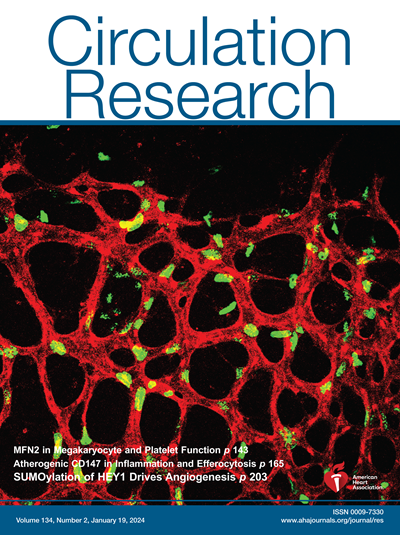摘要P359:用于心脏组织工程的成熟诱导多能干细胞衍生心肌细胞的导电支架
IF 16.5
1区 医学
Q1 CARDIAC & CARDIOVASCULAR SYSTEMS
引用次数: 0
摘要
心脏病是全世界死亡的主要原因。心脏组织工程(CTE)旨在修复和替换心脏组织,提供一种解决方案。诱导多能干细胞(iPSC)衍生的心肌细胞(CM)由于其提供无限的患者特异性CM的理论能力,可能会彻底改变CTE。然而,与功能性成人CM相比,iPSC CM在电生理上是不成熟的,因此不能维持心跳。因此,需要一种能够使iPSC CM电生理成熟的支架。我的研究通过引入碳纳米管(CNTs)来提高电纺(ES)支架的导电性,我假设由于其优异的导电性能,碳纳米管将使接种在其上的iPSC CM成熟。已经对ES聚己内酯(PCL)和明胶支架进行了形态、生物相容性和电学分析,其中通过“三明治”和双沉积方法掺入CNT,以提高导电性。通过ImageJ对SEM图像进行形态分析。纤维直径和孔径定量证实了通过改变溶液性质和ES参数来进行形态控制的能力,这对实现心脏细胞外基质的仿生至关重要。活/死分析和免疫荧光显示,CNT支架为NIH3T3成纤维细胞提供了高生物相容性,其附着、增殖和迁移良好。用万用表和双探针电阻测量进行的电学分析证实,CNT的加入显著提高了支架的导电性,双沉积支架比“三明治”支架更高,与CNT阵列平行的支架比正交的支架更高。这些结果证明了使用这种支架作为体外电生理iPSC CM成熟的方法的可行性。接下来的步骤包括支架的优化、iPSC CM生物相容性和反应的分析、心脏组织电生理学的概述和操作,包括心脏功能和成熟度标志物的量化,以及iPSC CM+支架对电起搏反应的评估。本文章由计算机程序翻译,如有差异,请以英文原文为准。
Abstract P359: Electroconductive Scaffolds To Mature Induced Pluripotent Stem Cell-derived Cardiomyocytes For Cardiac Tissue Engineering
Heart disease is the leading cause of death worldwide. Cardiac tissue engineering (CTE) aims to repair and replace heart tissue, offering a solution. Induced pluripotent stem cell (iPSC)-derived cardiomyocytes (CMs) could revolutionize CTE due to their theoretical ability to supply limitless patient-specific CMs. However, iPSC-CMs are electrophysiologically immature compared to functional adult CMs, and therefore incapable of sustaining a heartbeat.
Thus, a scaffold capable of electrophysiologically maturing iPSC-CMs is needed. My research increases the electroconductivity of electrospun (ES) scaffolds by incorporating carbon nanotubes (CNTs), which I hypothesize will mature iPSC-CMs seeded onto them due to their excellent electroconductive properties.
Morphological, biocompatibility, and electrical analyses have been performed on ES polycaprolactone (PCL) and gelatin scaffolds with CNTs incorporated via a ‘sandwich’ and dual deposition method in order to increase electroconductivity. Morphological analyses were performed via ImageJ on SEM images. Fiber diameter and pore size quantification confirmed the ability to exert morphological control by modifying solution properties and ES parameters, which is crucial to achieve biomimicry of the cardiac extracellular matrix. Live/dead assays and immunofluorescence revealed the CNT scaffolds offer high biocompatibility for NIH 3T3 fibroblasts, which attach, proliferate, and migrate well. Electrical analysis performed with a multimeter and two-probe resistance measurement confirms that inclusion of CNTs significantly increases scaffold conductivity, moreso for dual deposition scaffolds than ‘sandwich’ ones, and moreso parallel to the CNT arrays than orthogonally.
These results prove the feasibility of using such scaffolds as a method for
in vitro
electrophysiological iPSC-CM maturation. Next steps include optimization of scaffolds, analysis of iPSC-CM biocompatibility and response, and recapitulation and manipulation of the electrophysiology of cardiac tissue, including quantification of markers for cardiac function and maturity, and assessment of iPSC-CM + scaffold response to electrical pacing.
求助全文
通过发布文献求助,成功后即可免费获取论文全文。
去求助
来源期刊

Circulation research
医学-外周血管病
CiteScore
29.60
自引率
2.00%
发文量
535
审稿时长
3-6 weeks
期刊介绍:
Circulation Research is a peer-reviewed journal that serves as a forum for the highest quality research in basic cardiovascular biology. The journal publishes studies that utilize state-of-the-art approaches to investigate mechanisms of human disease, as well as translational and clinical research that provide fundamental insights into the basis of disease and the mechanism of therapies.
Circulation Research has a broad audience that includes clinical and academic cardiologists, basic cardiovascular scientists, physiologists, cellular and molecular biologists, and cardiovascular pharmacologists. The journal aims to advance the understanding of cardiovascular biology and disease by disseminating cutting-edge research to these diverse communities.
In terms of indexing, Circulation Research is included in several prominent scientific databases, including BIOSIS, CAB Abstracts, Chemical Abstracts, Current Contents, EMBASE, and MEDLINE. This ensures that the journal's articles are easily discoverable and accessible to researchers in the field.
Overall, Circulation Research is a reputable publication that attracts high-quality research and provides a platform for the dissemination of important findings in basic cardiovascular biology and its translational and clinical applications.
 求助内容:
求助内容: 应助结果提醒方式:
应助结果提醒方式:


